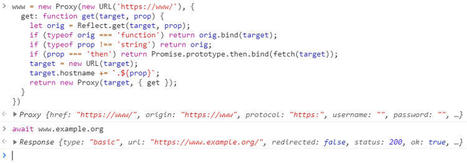 Your new post is loading...
 Your new post is loading...

|
Scooped by
nrip
|
Python is not the only option for programming machine learning applications. There’s a growing community of developers who are using JavaScript to run machine learning models. While JavaScript is not a replacement for the rich Python machine learning landscape (yet), there are several good reasons to have JavaScript machine learning skills. Here are four. Private machine learning Fast and customized ML models Easy integration of machine learning in web and mobile applications Server side JavaScript machine learning is maturing JavaScript for programming machine learning offers several advantages over Python and R, namely privacy, speed, and staying on the device. read more at https://venturebeat.com/2021/04/23/4-reasons-to-learn-machine-learning-with-javascript/

|
Scooped by
nrip
|
Static analysis is the practice of analyzing source code before it is running. In compiled programming languages, static analysis might be built into the compiler, but in dynamically interpreted languages like JavaScript, static analysis tools must be configured to run on the code sometime before it is deployed. Static analysis in JavaScript can drastically improve your code quality. Take a look at how so, some available tools and tips for implementing this practice. Because static analysis can be fully automated, it’s one of the best ways to improve the quality of your JavaScript code without investing developer time. But how exactly can static analysis help, and what tools are available to JavaScript developers? 1. Formatting and Styling Code The most common tools for static analysis in the JavaScript ecosystem—ESLint, JSHint, Prettier, Standard—are primarily used to ensure consistency in a team’s codebase. 2. Detecting Bugs and Errors While no substitute for testing, several static analysis tools can be used to catch likely errors before code is ever run. ESLint, PMD, Prettier and Standard are all good free tools that have rules for this kind of error detection. 3. Enforcing Best Practices You can enforce best practices automatically using static analysis. Prettier and Standard include opinionated rules about best practices, while ESLint and PMD are a bit more configurable. 4. Measuring Complexity If you want to catch increasing complexity or limit the cyclomatic complexity of your source code, Plato, ESLint or complexity-report are good static analysis tools for you. 5. Analyzing Security Risks While you can’t depend on static analysis alone to prevent security vulnerabilities, it’s certainly worth automating what you can. While some of the tools above indirectly improve security by decreasing likely bugs, LGTM is a security-focused tool that takes a novel approach Using the knowledge that common bugs are repeated across projects, LGTM scans thousands of large open-source projects to help you spot similar bugs in your codebase. This may lead to a lot of false alerts, but it might be worth trying in your project. 6. Auditing Third-Party Dependencies JavaScript applications tend to rely on many third-party libraries and frameworks. This makes development faster, but it puts a huge strain on teams that have to keep these third-party dependencies up to date. Fortunately, static analysis tools can help remind you when updates are required and even automatically manage this upgrade process. - Dependabot 7. Checking Types JavaScript applications can use type checking using tools like Flow or TypeScript to ensure consistent use of variable types. read the entire post at https://www.telerik.com/blogs/going-beyond-eslint-overview-static-analysis-javascript

|
Scooped by
nrip
|

|
Scooped by
nrip
|
Technical careers specialist Dice dove into job posting data to chart the salaries associated with popular programming languages, finding that Microsoft's TypeScript fares well in both accounts. The job data comes from Burning Glass, which provides real-time job market analytics. Dice combed through the data to determine which programming languages are most in-demand and how much they pay Those are two vital questions as technologists and developers everywhere decide which skills to learn next. See the attached photograph. TypeScript pays fairly well (fifth), but really shines in projected 10-year growth, where an astounding predicted rate of 60 percent dwarfs all other languages. Dice opined more about TypeScript specifically. "It's worth calling out TypeScript here. Technically, it's a superset of the ultra-popular and well-established JavaScript, which means that whatever you code in it is transpiled to JavaScript. That being said, many programming-language rankings (such as RedMonk) treat it as a full programming language. However you define it, it's clear that the language is on a strong growth trajectory, paired with a solid median salary. If you're looking for a new programming language to learn, keep an eye on it." read the whole report here: https://visualstudiomagazine.com/articles/2021/04/01/typescript-csharp.aspx For a quickstart to Typescript for tjose of you know who know javascript look here --> https://www.typescriptlang.org/docs/handbook/typescript-in-5-minutes.html

|
Scooped by
nrip
|
There are several states in a JavaScript web app that keep on changing on the basis of user behavior, time, and other reasons. For example, creating a new to-do item in a ‘To Do list’ app will eventually change the current state of the application to the new state with the to-do item involved. Since the state of the application is changed, the view through which the current state is presented with changes, and it eventually allows users to see the new to-do item in their view. However, if the state of an application doesn’t behave as expected, then it’s possibly the right time to debug the app. Redux framework is a way to manage the complete state of a JavaScript application through a centralized interface. In Redux each component of a web app can directly access the application’s state without sending down the props to child components. Redux is a conventional state container for JavaScript applications. This state management tool is frequently used with the React JavaScript library, and it helps build web applications that can easily operate in different environments and behave consistently. Redux has a large ecosystem of add-ons that ultimately makes it suitable to be used together with React website templates as well as other view libraries. On top of all that, React Redux can easily provide a great and dynamic developer experience, along with many amazing benefits. Read the tutorial at : https://www.wrappixel.com/beginners-guide-to-react-redux-heres-how-to-get-started/ to learn about - How does the Redux framework work?
- Basics of React Redux
- Action(s)
- Reducer(s)
- Action Type
- Redux Store
- Simple Styling for React Redux Components
- Integrating React Redux within a User interface
- Why do developers prefer React Redux?
- Why should you use Redux?
- The way forward: The best online tutorials to master Redux from scratch.
|

|
Scooped by
nrip
|
Traditionally, developers have created properties inside of JavaScript classes for any data that might be needed within an instance. This isn’t a problem for small pieces of data that are readily available inside of the constructor. However, if some data needs to be calculated before becoming available in the instance, you may not want to pay that cost upfront. It may not be efficient to perform a calculation upfront if you aren’t sure the property will be used. Fortunately, there are several ways to defer these operations until later. The on-demand property pattern The easiest way to optimize performing an expensive operation is to wait until the data is needed before doing the computation. For example, you could use an accessor property with a getter to do the computation on demand The messy lazy-loading property pattern Only performing the computation when the property is accessed is a good start. What you really need is to cache the information after that point and just use the cached version. But where do you cache that information for easy access? The easiest approach is to define a property with the same name and set its value to the computed data The only-own lazy-loading property pattern for classes If you have a use case where it’s important for the lazy-loaded property to always exist on the instance, then you can using Object.defineProperty() to create the property inside of the class constructor. It’s a little bit messier than the previous example, but it will ensure that the property only ever exists on the instance The lazy-loading property pattern for object literals If you are using an object literal instead of a class, the process is much simpler because getters defined on object literals are defined as enumerable own properties (not prototype properties) just like data properties. That means you can use the messy lazy-loading property pattern for classes without being messy Conclusion The ability to redefine object properties in JavaScript allows a unique opportunity to cache information that may be expensive to compute. By starting out with an accessor property that is redefined as a data property, you can defer computation until the first time a property is read and then cache the result for later use. This approach works both for classes and for object literals, and is a bit simpler in object literals because you don’t have to worry about your getter ending up on the prototype. One of the best ways to improve performance is to avoid doing the same work twice, so any time you can cache a result for use later, you’ll speed up your program. Techniques like the lazy-loading property pattern allow any property to become a caching layer to improve performance. read this post with more details and code examples at https://humanwhocodes.com/blog/2021/04/lazy-loading-property-pattern-javascript/

|
Scooped by
nrip
|
Style guides for Google-originated open-source projects “Style” covers a lot of ground, from “use camelCase for variable names” to “never use global variables” to “never use exceptions.” This project (google/styleguide) links to the style guidelines we use for Google code. If you are modifying a project that originated at Google, you may be pointed to this page to see the style guides that apply to that project. This project holds the Python Style Guide, HTML/CSS Style Guide, JavaScript Style Guide, TypeScript Style Guide, AngularJS Style Guide, C++ Style Guide, C# Style Guide, Swift Style Guide, Objective-C Style Guide, Java Style Guide, R Style Guide, Shell Style Guide, Common Lisp Style Guide, and Vimscript Style Guide. If your project requires that you create a new XML document format, the XML Document Format Style Guide may be helpful. In addition to actual style rules, it also contains advice on designing your own vs. adapting an existing format, on XML instance document formatting, and on elements vs. attributes.

|
Scooped by
nrip
|
Python creator Guido van Rossum reveals the strengths and weaknesses of one of the world's most popular programming languages. mobile app development is one of the key growth fields that Python hasn't gained any traction in, despite it dominating in machine learning with libraries like NumPy and Google's TensorFlow, as well as backend services automation. Python isn't exactly boxed into high-end hardware, but that's where it's gravitated to and it's been left out of mobile and the browser, even if it's popular on the backend of these services, he said. Why? Python simply guzzles too much memory and energy from hardware, he said. For similar reasons, he said Python probably doesn't have a future in the browser despite WebAssembly, a standard that is helping make more powerful applications on websites. Mobile app development in Python is a "bit of a sore point", said van Rossum in a recent video Q&A for Microsoft Reactor. "It would be nice if mobile apps could be written in Python. There are actually a few people working on that but CPython has 30 years of history where it's been built for an environment that is a workstation, a desktop or a server and it expects that kind of environment and the users expect that kind of environment," he said. "The people who have managed to cross-compile CPython to run on an Android tablet or even on iOS, they find that it eats up a lot of resources," he said. "Compared to what the mobile operating systems expect, Python is big and slow. It uses a lot of battery charge, so if you're coding in Python you would probably very quickly run down your battery and quickly run out of memory," he said. "Python is a pretty popular language [at the backend]. At Google I worked on projects that were sort of built on Python, although most Google stuff wasn't. At Dropbox, the whole Dropbox server is built on Python. On the other hand, if you look at what runs in the browser, that's the world of JavaScript and unless it translates to JavaScript, you can't run it," van Rossum said. "I don't mind so much different languages have to have different goals i mean nobody is asking Rust when you can write Rust in the browser; at least that wouldn't seem a useful sort of target for Rust either. Python should focus on the application areas where it's good and for the web that's the backend and for scientific data processing." watch the Microsoft Q&A with him at https://www.youtube.com/watch?v=aYbNh3NS7jA read the original article at https://www.zdnet.com/article/python-programming-why-it-hasnt-taken-off-in-the-browser-or-mobile-according-to-its-creator/

|
Scooped by
nrip
|
For some of us—isolates, happy in the dark—code is therapy, an escape and a path to hope in a troubled world A little over a year ago, as the Covid-19 lockdowns were beginning to fan out across the globe, most folks grasped for toilet paper and canned food. The thing I reached for: a search function. Reductively, programming consists of little puzzles to be solved. Not just inert jigsaws on living room tables, but puzzles that breathe with an uncanny life force. Puzzles that make things happen, that get things done, that automate tedium or allow for the publishing of words across the world. Break the problem into pieces. Put them into a to-do app (I use and love Things). This is how a creative universe is made. Each day, I’d brush aside the general collapse of society that seemed to be happening outside of the frame of my life, and dive into search work, picking off a to-do. Covid was large; my to-do list was reasonable. The real joy of this project wasn’t just in getting the search working but the refinement, the polish, the edge bits. Getting lost for hours in a world of my own construction. Even though I couldn’t control the looming pandemic, I could control this tiny cluster of bits. The whole process was an escape, but an escape with forward momentum. Getting the keyboard navigation styled just right, shifting the moment the search payload was delivered, finding a balance of index size and search usefulness. And most important, keeping it all light, delightfully light. And then writing it up, making it a tiny “gist” on GitHub, sharing with the community. It’s like an alley-oop to others: Go ahead, now you use it on your website. Super fast, keyboard-optimized, client side Hugo search. It's not perfect, but it’s darn good enough. read the original story at https://www.wired.com/story/healing-power-javascript-code-programming/

|
Scooped by
nrip
|
Here’s a sure indication that Node.js is getting big: more employers are marking the server-side framework with JavaScript as a required job skill.
The fact that demand for Node.js jobs has grown so starkly since 2011 indicates the framework’s potential to remake the programming landscape. As need for their talent grows, Node.js developers could be some of the most highly sought after in the future.
An increasingly mobile Web has paralleled the rise of Node.js. Mobile devices make up at least 30% of total Web traffic, and Node.js is a framework with a lot to offer mobile app developers.
Mobile apps are designed to serve Web pages to mobile users. Most of the heavy lifting goes on in the back end of a mobile app, where websites are made available and managed. That means back-end frameworks, like lightweight Node.js, are enjoying a moment in the spotlight.
Node.js makes a great back-end framework for mobile development because its core purpose is to respond to network requests. The way this works on mobile is that iOS, Android and other mobile web clients connect to NodeJS over HTTP to send requests through an API.
Since Node.js is an asynchronous framework, it is able to handle multiple HTTP requests in tandem, and therefore handle more traffic than many competing back-end frameworks. Combine it with Node.js’s ease of development (since it uses popular language JavaScript), and you’ve got the technical explanation for why developers refer to Node.js as fast or “responsive.”
Larger technology companies have already noticed the appeal. In 2011, LinkedIn swapped Ruby on Rails for an overhauled mobile app running Node.js.
The spike in job listings is an indication that still more companies are hoping to adopt Node.js into their mobile plans. Developers, it’s time to list “Node.js” higher up on your resumes.
more at http://readwrite.com/2014/07/15/bet-big-node-js
|



 Your new post is loading...
Your new post is loading...
















